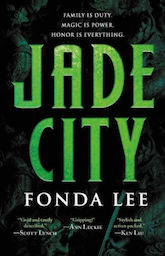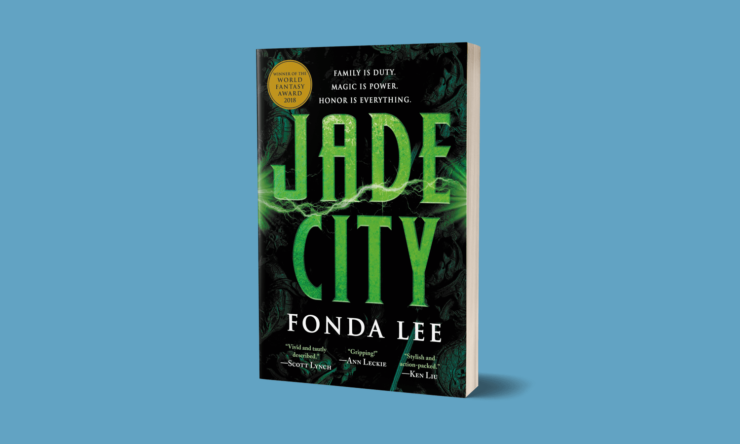The first time I read Jade City, I was in awe. It was the first fantasy novel I had read in which an Asian-signifying culture is not portrayed as the icky-gooey evil the protagonist has to escape in order to find themselves, save the world, and/or ensure the inevitable progress of civilization. Even as the characters acknowledge the sexism and emphasis on bloodline that comes with their physical prowess-based honor culture, the Kekonese are never presented as inherently less deserving of dignity than the Western-signifying Espenians—in fact, the Espenians, known for their willingness to pay and be paid off for just about anything, are the slippery ones, the invading threat, mercenary connivers devoid of a moral code.
And then, of course, there’s jade.
In this world, bio-energetic jade grants superhuman martial arts skills to properly trained Kekonese— the ability to leap over cars, deflect bullets, punch hard enough to crush six bricks. And by function of past personal ignorance, as well as the preferences and structures of the publishing industry, this intentional, fantastical elevation of people who looked like me—as opposed to white Chosen Ones who come into only marginal contact with a monolithic Asian-signifying country—felt something like a first time. Growing up in Iowa, I had watched the occasional Cantonese martial arts movie; I’d read a scattering of fantasy featuring Asian-signifying characters who were decent with swords. But Kekon was Wakanda to my isolated-incidents-in-Oakland: a society both Asian-signifying and respected within a world of diverse, competing nations, one that captures the world’s military, economic, and even creative interest with a substance and the ability to wield it that is (traditionally) unique to its land and its people.
In Kekon, two clans, No Peak and the Mountain, control the majority of the country’s jade; each wields a powerful business arm and a street army of jade-wearing fighters. Even in peacetime, though, these clans are woven into the very fabric of Kekonese society, influencing construction permits and workplace promotions, restaurant patronage and the recruitment of graduates from martial arts schools into their ranks. On my first read, I was swept away by the heady appeal of self-insertion, a pride of belonging in a fantasy world that I hadn’t felt since I was an eight-year-old curled up with Harry Potter and the Sorcerer’s Stone. To think someone who looked like me could do something like that… To think I could, in this imaginary space, swear fealty to an entity with access to the highest reaches of society, could dream myself into the shoes of someone with a power that the hundreds of books about princesses and faeries and magic girls that I’d read as a kid had subtly hinted was not mine to claim.
To think I could have a story arc other than the familiar struggle against my parents’ expectations and the ghosts of China, in which my directly descended family has not lived since at least the late 1800s.
Buy the Book


Jade City
In this way, Jade City was a revelation. Even more, however, it codified all the tiny things my parents had said and done to enforce filial piety and “right behavior,” which I had previously seen as irrational, annoying, backward. In America, one does not call elder family members by name to signify respect when one could simply say hello. One does not pursue a career one is not passionate about simply because one’s family “needs” one to. In every other book I’d read, these customs were obstacles to progress. They were the conflict that had to be worked out to achieve resolution. They could not be culture in the way that my experiences at school were a culture, I thought, because they had no origin story, no overarching narrative logic. Jade City makes worldbuilding of these unwritten rules. It reifies them in a legible code of behavior, and includes characters who find it perfectly ordinary to deflect compliments, consider family the primary unit of society, and act, often by default, for the good of clan or country rather than individual ego. Yet the characters who behave this way occupy primary roles in the story as well as supporting ones, and none is boxed neatly into the trope of the overbearing parent who has to be defied for the sake of personal growth, or the rebellious young adult who breaks free of family expectations, superstition, and/or silence to find true family in a more expressive, Western-signifying friend group. Even the decaying grandfather was a war hero, once.
To misquote a poet: Kekon was a structure, not an event, and it gave me a place to live inside.
Then I spent some time back at my parents’ house.
Clashing daily against the expectation to cook, wash the dishes, marry, and have children has a way of putting a damper on one’s romanticizations of truly “belonging,” as it were, to a communal culture. After viewing the idea for years in the abstract, I was confronted with the question of who benefits from such a system—whose role is re-mapped from individual worker to compellingly burdened leader, from personal excellence to the emblem of an impeccable whole—and whose translated role appears, through the old individualistic lens, to be a shameful demotion. In Jade City, Shae, the main female point-of-view character, returns to the clan after two years of business school in British- or American-coded Espenia, and experiences a probable backslide in power on the axis of sex and gender. However, this is offset by her taking up her jade again, as she has more of it than almost any other Green Bone fighter in the world. Similarly, the series’ main antagonist, Mountain clan leader Ayt Madashi, makes up for the societal disadvantage of being a woman with sheer ruthlessness, killing every other possible male clan leader in order to ascend and transgressing once-ironclad societal rules about the non-involvement of jadeless civilians in order to win the war against No Peak. But what of people who lack the proper “compensation” for their womanhood, like Shae’s mother, with her seaside cottage and her watercolor lessons, or even Wen, who is without jade abilities and, for the majority of the book, stays at her husband’s home to serve drinks to clan fighters and decorate her living room? Do we identify with them? Do we want to?
As a reader, am I actually excited about the culture being portrayed, or just the fact that certain members of the decision-making class look like me?
I say I want to decolonize my brain. I say I want to decenter Western culture in my writing. I have thought, for a long time, about what it means to do the work, what volume of research I would need to deal with in order to defend any story I write in this vein. But does immersing myself in my parents’ way of thinking—i.e. with an open mind toward actually accepting its values—mean giving up my idea of what it means to be a writer? Does it mean no longer asking why in the way that a thousand books, written in English, have taught me to do? Does it mean acknowledging that there is, in fact, a “natural” way of things, that women were meant to cook and bear children, to serve?
In this world, a world without jade, what does it mean to claim a paradigm I am not sure, even now, that I want to claim?
And what allegiance do I have to it in the first place?
My parents came from Malaysia by way of their grandparents’ immigration from southern China, but they have little loyalty to Malaysia as a country. Although our extended family lives there, the bond I have observed between my parents and other ethnic Chinese who come from outside of mainland China (i.e. Taiwan, Hong Kong) is about as strong, my father told me recently, as meeting a Chinese person who came from his birth country. The land itself is temporary, a slate upon which apartment buildings may be constructed, business conducted. And thirty years after my parents first immigrated to the States, I still don’t know how to truly ask them about the place, or parse the way they speak about it, as if about a distant acquaintance. All I know is that my father grew up reading Hans Christian Anderson alongside Chinese classics and thought them “naturally” better stories, that he disdained the way his relatives sat in front of Chinese TV dramas for hours at a time. All I know is that he grew up wanting to leave.
Recently, a friend of mine pointed out that Kekon, while deliberately constructed not to resemble any one specific Asian country , has a history quite similar to that of Korea—the guerrilla forest fighting, the Western military interference, a mythology in which their people were chosen by the gods—and she’s absolutely right. Food-wise, Kekon may run closer to the dim sum I remember being driven the three hours to Chicago’s Chinatown for as a child, but in its history, in the pride of its blood, there is a sense of national identity and joined struggle there that is absent in my family with no records, my grandparents with their elementary-school education. All I know of their intersections with Malaysia’s history, without consulting Wikipedia, was that my paternal grandmother was selling cigarettes to Japanese soldiers by the time she was twelve. The tongue is a void, says the narrator of Ocean Vuong’s On Earth We’re Briefly Gorgeous, in reference to of his mother’s second-grade-level Vietnamese—the mother tongue no mother at all, but an orphan. So, too, is the country in which my parents were born; so, too, is my ancestors’ joy and pain, their unrecorded grief or elation at leaving and starting anew, the four or more dialects in which we might have communicated. I may have not asked after my heritage, but so too has it never been deliberately passed on.
You may say, of course, that Jade City takes place in a fantasy world, that I can extrapolate. Yes. I know how—I’ve been doing it my whole life. Yet as I wander the rolling hills of this fantasy that is at once a mirror and not quite, I want to ask—who does this kind of history belong to? What allegiance do I have—should I have—to something I was never really a part of? There’s an abundance of science fiction and fantasy coming from actual Malaysians—as a writer, what right do I have to claim the place as a research project to which my heritage makes me uniquely entitled, when I have seen only the barest facets of the place and others live inside it daily? And if I believe I do have the right, if I believe any story can be told by anyone as long as they put in the work—is it worth, specifically, my work?
I can’t say I have the answers. I can’t even say I’m asking the right questions—that, through a haze of decades of internalized racism, of assuming a blank slate that I have only recently discovered was wiped on purpose, I can even know how to begin to approach everything that has been left unsaid. But Jade City cracked the lens with which I had viewed the world in the best of ways, and I am grateful for the fracture.
Here’s to hoping it lets more light in.
Phoebe Low has work published or forthcoming on Star*Line, Not One of Us, and Mithila Review. She is a proud graduate of Viable Paradise 23, and can be found on Twitter @_lowpH.










